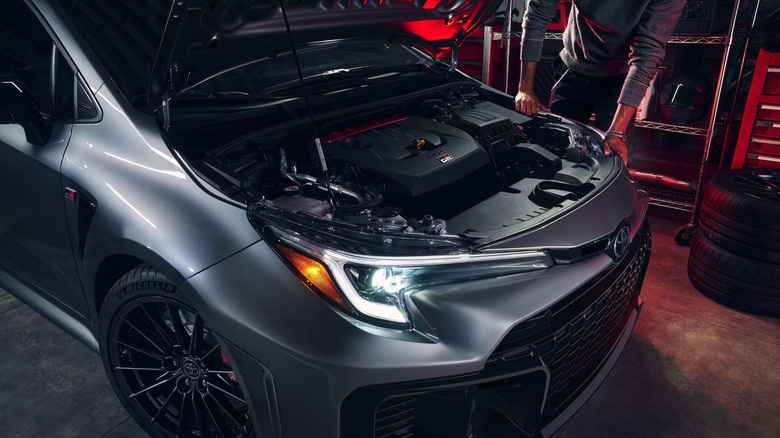Why The Toyota Corolla GR Has A Three-Cylinder Engine
The Toyota GR Corolla is one of the best enthusiast cars on sale in America right now. It has the right recipe to impress those who love driving. The GR Corolla has roots in rally racing, and it's a hot hatch with AWD, a manual gearbox, and also a turbocharged engine. Many people were not impressed by the fact that it gets a three-cylinder engine, especially when the non-GR Corolla comes with a 1.5-liter four-cylinder.
The Toyota GR team had already developed the three-cylinder for the GR Yaris, and that's what the GR Corolla's engine has been derived from. For the American market, Toyota tinkered with the engine a bit to give it more power and enhance cooling, mostly to compensate for the added weight of the Corolla, and also giving it a little bit of more oomph. The 1.6-liter G16E-GTS engine produces 300 hp and 295 lb-ft of torque in the GR Corolla, which is ample for a car of this size.
There are a few reasons why Toyota chose a three-cylinder over a four-cylinder engine. For one, the GR Corolla can achieve better efficiency while staying compact. It's also lighter than a four-cylinder of the same size, can produce good power, and doesn't it produce as many exhaust gases, which allowed the engineers to minimize back pressure.
Three-cylinder vs. four-cylinder: Which is better?
All types of engines have their own advantages. A three-cylinder engine might be better than a four-cylinder in some aspects, but this is solely decided by the manufacturers needs, efficiency, costs, and the amount of compromise they are willing to make to achieve the goal.
Three-cylinder engines have been used extensively in smaller cars, mainly due to their footprint and their ability to achieve more efficiency. Good power can also be made with modern turbocharging, and it's also lighter compared to a four-cylinder. Three-cylinder engines also have great primary and secondary balance, but since there are no even number of cylinders, there is a rocking couple, which can make them unrefined, forcing manufacturers to use a balancer shaft to cut down vibrations.
Similarly, four-cylinders have their own advantages. There is no rocking couple because there is an even number of cylinders, which means there are less vibrations. While four-cylinder engines are primary balanced, they are not secondary balanced. The 90-degree crankshaft is balanced, however, and they are quite smooth in their operation. They are, however, larger, more expensive to make, and also heavier, reducing their overall efficiency.

